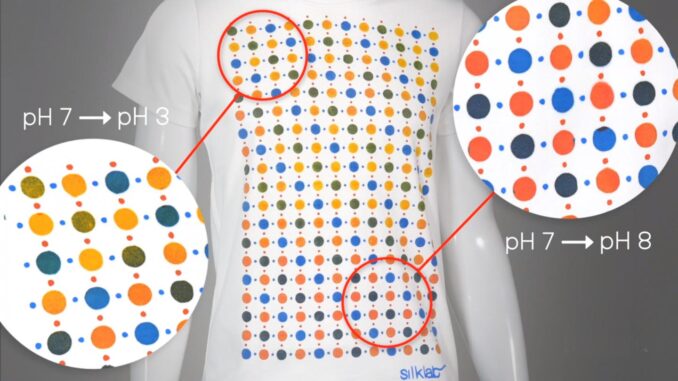
“New smart fabrics can provide a high resolution color-coded map of body response and the environment.”
Source: TUFTS UNIVERSITY
MEDFORD/SOMERVILLE, Mass. (June 5, 2020)–Researchers at Tufts University’s School of Engineering have developed biomaterial-based inks that respond to and quantify chemicals released from the body (e.g. in sweat and potentially other biofluids) or in the surrounding environment by changing color. The inks can be screen printed onto textiles such as clothes, shoes, or even face masks in complex patterns and at high resolution, providing a detailed map of human response or exposure. The advance in wearable sensing, reported in Advanced Materials, could simultaneously detect and quantify a wide range of biological conditions, molecules and, possibly, pathogens over the surface of the body using conventional garments and uniforms.
“The use of novel bioactive inks with the very common method of screen printing opens up promising opportunities for the mass-production of soft, wearable fabrics with large numbers of sensors that could be applied to detect a range of conditions,” said Fiorenzo Omenetto, corresponding author and the Frank C. Doble Professor of Engineering at Tufts’ School of Engineering. “The fabrics can end up in uniforms for the workplace, sports clothing, or even on furniture and architectural structures.”
Wearable sensing devices have attracted considerable interest in monitoring human performance and health. Many such devices have been invented incorporating electronics in wearable patches, wristbands, and other configurations that monitor either localized or overall physiological information such as heart rate or blood glucose. The research presented by the Tufts team takes a different, complementary approach – non-electronic, colorimetric detection of a theoretically very large number of analytes using sensing garments that can be distributed to cover very large areas: anything from a patch to the entire body, and beyond.
The components that make the sensing garments possible are biologically activated silk-based inks. The soluble silk substrate in these ink formulations can be modified by embedding various “reporter” molecules – such as pH sensitive indicators, or enzymes like lactate oxidase to indicate levels of lactate in sweat. The former could be an indicator of skin health or dehydration, while the latter could indicate levels of fatigue of the wearer. Many other derivatives of the inks can be created due to the versatility of the silk fibroin protein by modifying it with active molecules such as chemically sensitive dyes, enzymes, antibodies and more. While the reporter molecules could be unstable on their own, they can become shelf-stable when embedded within the silk fibroin in the ink formulation.
The inks are formulated for screen printing applications by combining with a thickener (sodium alginate) and a plasticizer (glycerol). The screen printable bio-inks can be used like any ink developed for screen printing, and so can be applied not just to clothing but also to various surfaces such as wood, plastics and paper to generate patterns ranging from hundreds of microns to tens of meters. While the changes in color presented by the inks can provide a visual cue to the presence or absence of an analyte, use of camera imaging analysis scanning the garments or other material can gather more precise information on both quantity and high resolution, sub-millimeter mapping.
The technology builds upon earlier work by the same researchers developing bioactive silk inks formulated for inkjet-printing to create petri dishes, paper sensors, and laboratory gloves that can indicate bacterial contamination by changing colors.
“The screen printing approach provides the equivalent of having a large, multiplexed arrangement of sensors covering extensive areas of the body, if worn as a garment, or even on large surfaces such as room interiors,” said Giusy Matzeu, research assistant professor of biomedical engineering at Tufts School of Engineering and first author of the paper. “Coupled with image analysis, we can obtain a high resolution mapof color reactions over a large area and gain more insight on overall physiological or environmental state. In theory, we could extend this method to track air quality, or support environmental monitoring for epidemiology.”
The fact that the method uses common printing techniques also opens up avenues in creative applications – something explored by Laia Mogas-Soldevila, architect and recent PhD graduate at Tufts in Omenetto’s SilkLab. Mogas-Soldevila has helped to create beautiful tapestries, displaying them in museums across the United States and Europe. The displays are interactive, allowing visitors to spray different, non-toxic chemicals onto the fabric and watch the patterns transform. “This is really a great example of how art and engineering can gain from and inspire each other,” said Mogas-Soldevila. “The engineered inks open up a new dimension in responsive, interactive tapestries and surfaces, while the 1,000-year old art of screen printing has provided a foundation well suited to the need for a modern high resolution, wearable sensing surface.”
Reference: Giusy Matzeu Laia Mogas‐Soldevila Wenyi Li Arin Naidu Trent H. Turner Roger Gu Patricia R. Blumeris Patrick Song Daniel G. Pascal Giulia Guidetti Meng Li Fiorenzo G. Omenetto Large‐Scale Patterning of Reactive Surfaces for Wearable and Environmentally Deployable Sensors :27 May 2020 https://doi.org/10.1002/adma.202001258
###
The research was supported by grants from the U.S. Army Natick Soldier Research, Development and Engineering Center (W911QY-15-2-0001), the Office of Naval Research (N00014-19-1-2399), and a gift from the Stavros Niarchos Foundation (SNF).
Matzeu. G., Mogas-Soldevila, L., Li, W., Naidu, A., Turner, T.H., Gu, R., Blumeris, P.R., Song, P., Pascal, D.G., Guidetti, G., Li, M., and Omenetto, F.G. “Large-scale patterning of reactive surfaces for wearable and environmentally deployable sensors.” Advanced Materials 2020; DOI: 10.1002/adma. 202001258
About Tufts University
Tufts University, located on campuses in Boston, Medford/Somerville and Grafton, Massachusetts, and in Talloires, France, is recognized among the premier research universities in the United States. Tufts enjoys a global reputation for academic excellence and for the preparation of students as leaders in a wide range of professions. A growing number of innovative teaching and research initiatives span all Tufts campuses, and collaboration among the faculty and students in the undergraduate, graduate and professional programs across the university’s schools is widely encouraged.







Leave a Reply